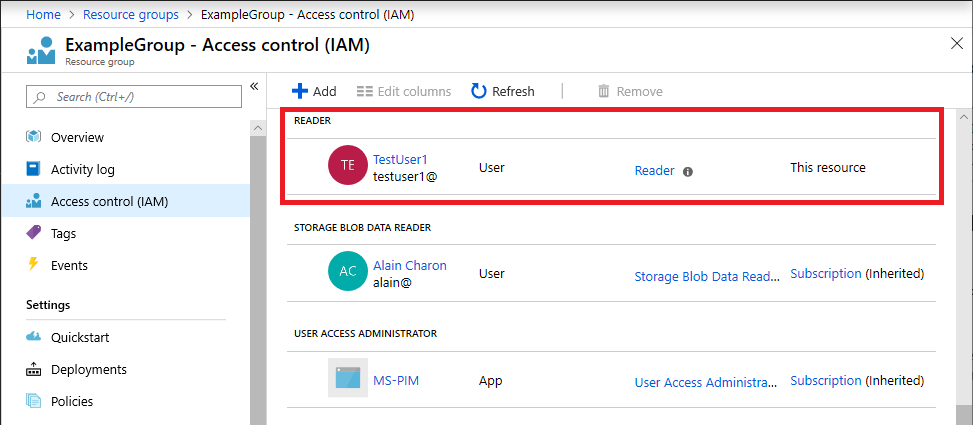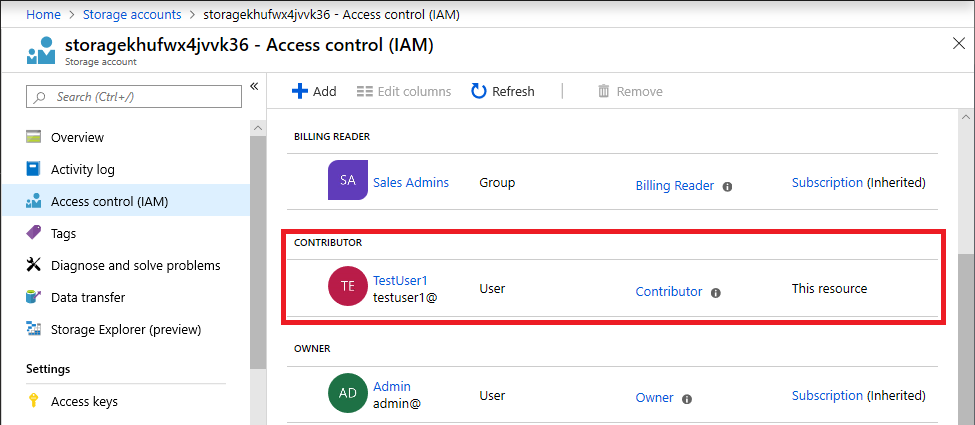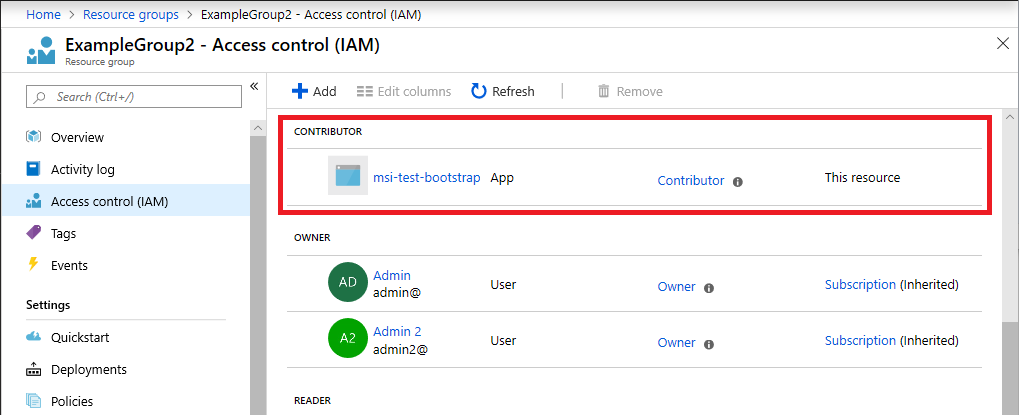Assign Azure roles using Azure Resource Manager templates
Azure role-based access control (Azure RBAC) is the authorization system you use to manage access to Azure resources. To grant access, you assign roles to users, groups, service principals, or managed identities at a particular scope. In addition to using Azure PowerShell or the Azure CLI, you can assign roles using Azure Resource Manager templates. Templates can be helpful if you need to deploy resources consistently and repeatedly. This article describes how to assign roles using templates.
Note
Bicep is a new language for defining your Azure resources. It has a simpler authoring experience than JSON, along with other features that help improve the quality of your infrastructure as code. We recommend that anyone new to infrastructure as code on Azure use Bicep instead of JSON.
To learn about how to define role assignments by using Bicep, see Create Azure RBAC resources by using Bicep. For a quickstart example, see Quickstart: Assign an Azure role using Bicep.
Prerequisites
To assign Azure roles, you must have:
Microsoft.Authorization/roleAssignments/writepermissions, such as Role Based Access Control Administrator or User Access Administrator
You must use the following versions:
2018-09-01-previewor later to assign an Azure role to a new service principal2020-04-01-previewor later to assign an Azure role at resource scope2022-04-01is the first stable version
For more information, see API versions of Azure RBAC REST APIs.
Get object IDs
To assign a role, you need to specify the ID of the user, group, or application you want to assign the role to. The ID has the format: 11111111-1111-1111-1111-111111111111. You can get the ID using the Azure portal, Azure PowerShell, or Azure CLI.
User
To get the ID of a user, you can use the Get-AzADUser or az ad user show commands.
$objectid = (Get-AzADUser -DisplayName "{name}").id
objectid=$(az ad user show --id "{email}" --query id --output tsv)
Group
To get the ID of a group, you can use the Get-AzADGroup or az ad group show commands.
$objectid = (Get-AzADGroup -DisplayName "{name}").id
objectid=$(az ad group show --group "{name}" --query id --output tsv)
Managed identities
To get the ID of a managed identity, you can use Get-AzAdServiceprincipal or az ad sp commands.
$objectid = (Get-AzADServicePrincipal -DisplayName <Azure resource name>).id
objectid=$(az ad sp list --display-name <Azure resource name> --query [].id --output tsv)
Application
To get the ID of a service principal (identity used by an application), you can use the Get-AzADServicePrincipal or az ad sp list commands. For a service principal, use the object ID and not the application ID.
$objectid = (Get-AzADServicePrincipal -DisplayName "{name}").id
objectid=$(az ad sp list --display-name "{name}" --query [].id --output tsv)
Assign an Azure role
In Azure RBAC, to grant access, you assign a role.
Resource group scope (without parameters)
The following template shows a basic way to assign a role. Some values are specified within the template. The following template demonstrates:
- How to assign the Reader role to a user, group, or application at a resource group scope
To use the template, you must do the following:
- Create a new JSON file and copy the template
- Replace
<your-principal-id>with the ID of a user, group, managed identity, or application to assign the role to
{
"$schema": "https://schema.management.azure.com/schemas/2015-01-01/deploymentTemplate.json#",
"contentVersion": "1.0.0.0",
"resources": [
{
"type": "Microsoft.Authorization/roleAssignments",
"apiVersion": "2022-04-01",
"name": "[guid(resourceGroup().id)]",
"properties": {
"roleDefinitionId": "[concat('/subscriptions/', subscription().subscriptionId, '/providers/Microsoft.Authorization/roleDefinitions/', 'acdd72a7-3385-48ef-bd42-f606fba81ae7')]",
"principalId": "<your-principal-id>"
}
}
]
}
Here are example New-AzResourceGroupDeployment and az deployment group create commands for how to start the deployment in a resource group named ExampleGroup.
New-AzResourceGroupDeployment -ResourceGroupName ExampleGroup -TemplateFile rbac-test.json
az deployment group create --resource-group ExampleGroup --template-file rbac-test.json
The following shows an example of the Reader role assignment to a user for a resource group after deploying the template.

Resource group or subscription scope
The previous template isn't very flexible. The following template uses parameters and can be used at different scopes. The following template demonstrates:
- How to assign a role to a user, group, or application at either a resource group or subscription scope
- How to specify the Owner, Contributor, and Reader roles as a parameter
To use the template, you must specify the following inputs:
- The ID of a user, group, managed identity, or application to assign the role to
- A unique ID that will be used for the role assignment, or you can use the default ID
{
"$schema": "https://schema.management.azure.com/schemas/2015-01-01/deploymentTemplate.json#",
"contentVersion": "1.0.0.0",
"parameters": {
"principalId": {
"type": "string",
"metadata": {
"description": "The principal to assign the role to"
}
},
"builtInRoleType": {
"type": "string",
"allowedValues": [
"Owner",
"Contributor",
"Reader"
],
"metadata": {
"description": "Built-in role to assign"
}
},
"roleNameGuid": {
"type": "string",
"defaultValue": "[newGuid()]",
"metadata": {
"description": "A new GUID used to identify the role assignment"
}
}
},
"variables": {
"Owner": "[concat('/subscriptions/', subscription().subscriptionId, '/providers/Microsoft.Authorization/roleDefinitions/', '8e3af657-a8ff-443c-a75c-2fe8c4bcb635')]",
"Contributor": "[concat('/subscriptions/', subscription().subscriptionId, '/providers/Microsoft.Authorization/roleDefinitions/', 'b24988ac-6180-42a0-ab88-20f7382dd24c')]",
"Reader": "[concat('/subscriptions/', subscription().subscriptionId, '/providers/Microsoft.Authorization/roleDefinitions/', 'acdd72a7-3385-48ef-bd42-f606fba81ae7')]"
},
"resources": [
{
"type": "Microsoft.Authorization/roleAssignments",
"apiVersion": "2022-04-01",
"name": "[parameters('roleNameGuid')]",
"properties": {
"roleDefinitionId": "[variables(parameters('builtInRoleType'))]",
"principalId": "[parameters('principalId')]"
}
}
]
}
Note
This template is not idempotent unless the same roleNameGuid value is provided as a parameter for each deployment of the template. If no roleNameGuid is provided, by default a new GUID is generated on each deployment and subsequent deployments will fail with a Conflict: RoleAssignmentExists error.
The scope of the role assignment is determined from the level of the deployment. Here are example New-AzResourceGroupDeployment and az deployment group create commands for how to start the deployment at a resource group scope.
New-AzResourceGroupDeployment -ResourceGroupName ExampleGroup -TemplateFile rbac-test.json -principalId $objectid -builtInRoleType Reader
az deployment group create --resource-group ExampleGroup --template-file rbac-test.json --parameters principalId=$objectid builtInRoleType=Reader
Here are example New-AzDeployment and az deployment sub create commands for how to start the deployment at a subscription scope and specify the location.
New-AzDeployment -Location centralus -TemplateFile rbac-test.json -principalId $objectid -builtInRoleType Reader
az deployment sub create --location centralus --template-file rbac-test.json --parameters principalId=$objectid builtInRoleType=Reader
Resource scope
If you need to assign a role at the level of a resource, set the scope property on the role assignment to the name of the resource.
The following template demonstrates:
- How to create a new storage account
- How to assign a role to a user, group, or application at the storage account scope
- How to specify the Owner, Contributor, and Reader roles as a parameter
To use the template, you must specify the following inputs:
- The ID of a user, group, managed identity, or application to assign the role to
{
"$schema": "https://schema.management.azure.com/schemas/2019-04-01/deploymentTemplate.json#",
"contentVersion": "1.0.0.0",
"parameters": {
"principalId": {
"type": "string",
"metadata": {
"description": "The principal to assign the role to"
}
},
"builtInRoleType": {
"type": "string",
"allowedValues": [
"Owner",
"Contributor",
"Reader"
],
"metadata": {
"description": "Built-in role to assign"
}
},
"roleNameGuid": {
"type": "string",
"defaultValue": "[newGuid()]",
"metadata": {
"description": "A new GUID used to identify the role assignment"
}
},
"location": {
"type": "string",
"defaultValue": "[resourceGroup().location]"
}
},
"variables": {
"Owner": "[concat('/subscriptions/', subscription().subscriptionId, '/providers/Microsoft.Authorization/roleDefinitions/', '8e3af657-a8ff-443c-a75c-2fe8c4bcb635')]",
"Contributor": "[concat('/subscriptions/', subscription().subscriptionId, '/providers/Microsoft.Authorization/roleDefinitions/', 'b24988ac-6180-42a0-ab88-20f7382dd24c')]",
"Reader": "[concat('/subscriptions/', subscription().subscriptionId, '/providers/Microsoft.Authorization/roleDefinitions/', 'acdd72a7-3385-48ef-bd42-f606fba81ae7')]",
"storageName": "[concat('storage', uniqueString(resourceGroup().id))]"
},
"resources": [
{
"apiVersion": "2019-04-01",
"type": "Microsoft.Storage/storageAccounts",
"name": "[variables('storageName')]",
"location": "[parameters('location')]",
"sku": {
"name": "Standard_LRS"
},
"kind": "Storage",
"properties": {}
},
{
"type": "Microsoft.Authorization/roleAssignments",
"apiVersion": "2022-04-01",
"name": "[parameters('roleNameGuid')]",
"scope": "[concat('Microsoft.Storage/storageAccounts', '/', variables('storageName'))]",
"dependsOn": [
"[variables('storageName')]"
],
"properties": {
"roleDefinitionId": "[variables(parameters('builtInRoleType'))]",
"principalId": "[parameters('principalId')]"
}
}
]
}
To deploy the previous template, you use the resource group commands. Here are example New-AzResourceGroupDeployment and az deployment group create commands for how to start the deployment at a resource scope.
New-AzResourceGroupDeployment -ResourceGroupName ExampleGroup -TemplateFile rbac-test.json -principalId $objectid -builtInRoleType Contributor
az deployment group create --resource-group ExampleGroup --template-file rbac-test.json --parameters principalId=$objectid builtInRoleType=Contributor
The following shows an example of the Contributor role assignment to a user for a storage account after deploying the template.

New service principal
If you create a new service principal and immediately try to assign a role to that service principal, that role assignment can fail in some cases. For example, if you create a new managed identity and then try to assign a role to that service principal in the same Azure Resource Manager template, the role assignment might fail. The reason for this failure is likely a replication delay. The service principal is created in one region; however, the role assignment might occur in a different region that hasn't replicated the service principal yet.
To address this scenario, you should set the principalType property to ServicePrincipal when creating the role assignment. You must also set the apiVersion of the role assignment to 2018-09-01-preview or later. 2022-04-01 is the first stable version.
The following template demonstrates:
- How to create a new managed identity service principal
- How to specify the
principalType - How to assign the Contributor role to that service principal at a resource group scope
To use the template, you must specify the following inputs:
- The base name of the managed identity, or you can use the default string
{
"$schema": "http://schema.management.azure.com/schemas/2015-01-01/deploymentTemplate.json#",
"contentVersion": "1.0.0.0",
"parameters": {
"baseName": {
"type": "string",
"defaultValue": "msi-test"
}
},
"variables": {
"identityName": "[concat(parameters('baseName'), '-bootstrap')]",
"bootstrapRoleAssignmentId": "[guid(concat(resourceGroup().id, 'contributor'))]",
"contributorRoleDefinitionId": "[concat('/subscriptions/', subscription().subscriptionId, '/providers/Microsoft.Authorization/roleDefinitions/', 'b24988ac-6180-42a0-ab88-20f7382dd24c')]"
},
"resources": [
{
"type": "Microsoft.ManagedIdentity/userAssignedIdentities",
"name": "[variables('identityName')]",
"apiVersion": "2018-11-30",
"location": "[resourceGroup().location]"
},
{
"type": "Microsoft.Authorization/roleAssignments",
"apiVersion": "2022-04-01",
"name": "[variables('bootstrapRoleAssignmentId')]",
"dependsOn": [
"[resourceId('Microsoft.ManagedIdentity/userAssignedIdentities', variables('identityName'))]"
],
"properties": {
"roleDefinitionId": "[variables('contributorRoleDefinitionId')]",
"principalId": "[reference(resourceId('Microsoft.ManagedIdentity/userAssignedIdentities', variables('identityName')), '2018-11-30').principalId]",
"principalType": "ServicePrincipal"
}
}
]
}
Here are example New-AzResourceGroupDeployment and az deployment group create commands for how to start the deployment at a resource group scope.
New-AzResourceGroupDeployment -ResourceGroupName ExampleGroup2 -TemplateFile rbac-test.json
az deployment group create --resource-group ExampleGroup2 --template-file rbac-test.json
The following shows an example of the Contributor role assignment to a new managed identity service principal after deploying the template.
